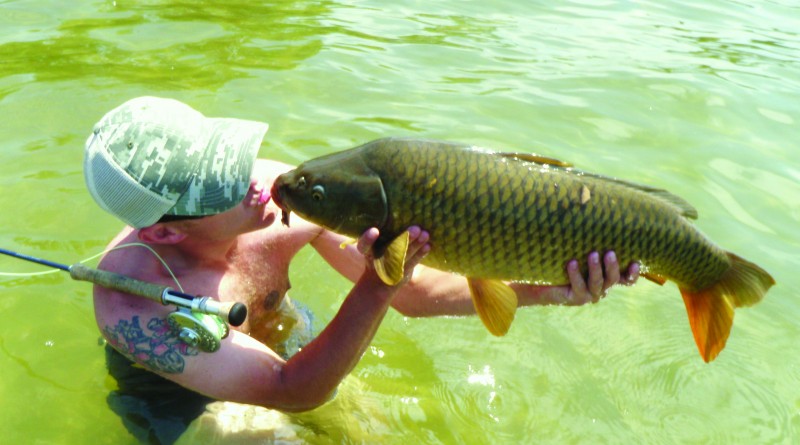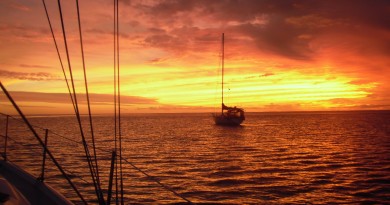Carp on the Fly
“Presentation is really critical,” says Drew Price, a fly fishing guide from Colchester. “Success rate is only 10-15 percent if your presentation is good. It can be really, really challenging.”
Is Price describing the delicate art of presenting a hand-tied caddis imitation to picky rainbows on highly pressured systems in the late spring? Throwing streamers for aggressive browns in the fall? Zeroing in on a rare steelhead run on Lake Champlain tributaries?
Try carp, that bottom-feeding bass-like fish common in Vermont’s larger streams and rivers and abundant in Lake Champlain.
“Carp are the hot species in fly fishing right now,” says Price. “I’ve been fishing them for 12 years, pretty seriously for the past six.”
Carp as Game Fish
Unlike native brookies, athletic rainbows, prehistoric browns, and many of Vermont’s other game fish, there is very little romance surrounding carp, historically a much-maligned “trash fish” known for rooting around in muddy flats in warmer water.
I first became aware that carp were a viable sporting option a few summers ago, when I was working in a fly shop in Idaho. My boss was a guy who regularly leads trips to such locales as the Seychelles and Mongolia; if there’s such a thing as a “good” permit angler, he’s probably one.
“So imagine my surprise when I asked him what his weekend plans were one Friday.
“You know, I’ve been thinking a lot about carp…” he mused.
Why Carp?
Since then, carp fishing has really blown up in the fly-fishing world. There are several reasons for this spike in popularity.
“If you think about it, they’re a freshwater fish that’s hard to catch, they get large, and they’ll take a fly,” Price explains. “This is a fish that will be measured in pounds, not inches.”
Price says 10-12 pounds is an average carp, but they get much bigger: his personal best is 35 pounds.
Carp are often billed as the “poor man’s bonefish,” sometimes called “golden bones.” Like their coveted saltwater counterpart, carp are a fish that can be sight-fished to in shallow flats while they are “mudding,” or rooting around for crayfish and nymphs.
Though they’re difficult to hook, once they’re on, the fight is incomparable.
“I would put them down as the fish on Lake Champlain you’re most likely to see your backing with. I’ve had my whole line and backing out, and broken off, in 30 seconds,” reports Price.
Carp are strong, fast fish, and while they may not leap like a rainbow or eat like a brown, they offer a thrill more in line with saltwater species like bonefish, which take off like a rocket when hooked-or simply spooked.
“When you hook an average sized carp, expect to play that fish for at least 10 minutes; 20 isn’t unusual,” Price says.
The advantage of carp is that they’re plentiful. An adaptive species, they have a musculature that is optimized to live in lower oxygen waters than other game fish. They can be found in waters up to 95 degrees, making them an ideal summer alternative to cold-water species.
How to Fish to Carp
The ideal scenario for catching a Lake Champlain carp is somewhat analogous to a saltwater flats situation: “mudding” fish—akin to tailing bonefish—have their mouths down and their tails up in the shallows, rooting for crayfish and nymphs.
Sometimes the fish can be waded to, but most often it is best to have a flat-bottomed boat that can be poled out to a pod of carp without alarming them. Ninety percent of carp fishing is sight fishing, according to Price, and stealth is important.
Having a strong, double-haul cast and good presentation is essential to putting a fly in front of mudding fish without spooking them in clear, shallow water. Casts of 20 to 50 feet are typical, and they need to be accurate on the first try.
“One of the biggest problems I see is trout anglers coming out for carp and trying to fish for trout, and they fail,” says Price. “Carp fishing isn’t trout fishing.”
Price says that a slow, strip retrieve is most effective. He fishes mostly subsurface flies—crayfish and nymph patterns—and says that sometimes he lets his fly sit still in the water to attract fish. The most important thing is to put the fly right on the carp’s nose without scaring it.
Carp generally cruise the shallows in loose pods, and are often found in weed beds. For this reason, a 6 to 8 weight rod is necessary to pull subsurface flies out of weeds when they are snagged.
Price also stresses the importance of fluorocarbon leaders. Fluoro leaders, as opposed to more common mono, or monofilament, leaders are almost invisible underwater. Fluorocarbon tends to be more expensive than monofilament, but Price says it’s worth the expense. He fishes a 3x leader.
“They’re one of the most challenging fish in the lake,” Price continued. “I fished for 50, 60 hours before I hooked into one.”
For intermediate or experienced fishermen who want to wet a fly when water is warm, or for those who want a taste of the flats fishing experience, a carp fishing expedition may be an opportunity to explore a unique and exotic style of fishing.
Price, however, strongly recommends starting out with a guide, to get the hang of it and start having success.
“It’s ridiculous there’s not more people doing it,” Price says of carp fishing. “Carp are hot now, and I’m one of the only people doing it.”


